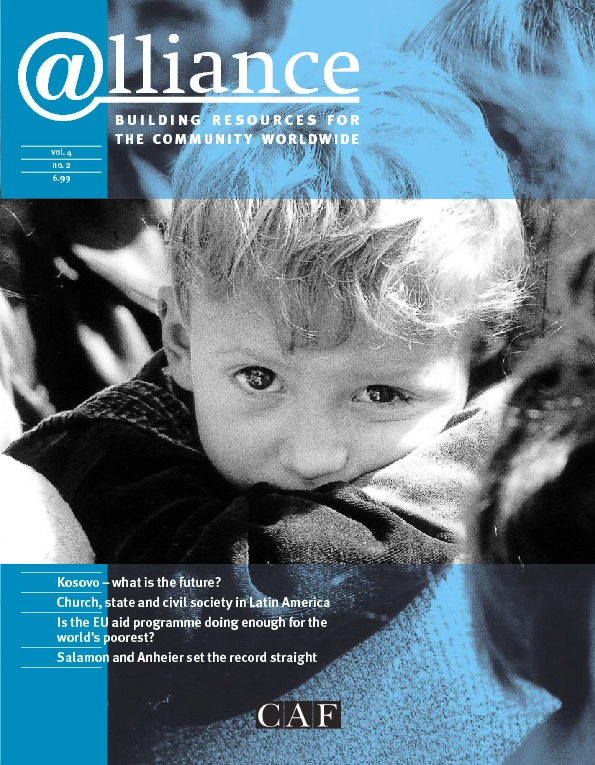Philanthropy promotion centres, or philanthropy support centres, seem to be springing up everywhere. Two of the most recent initiatives are in Pakistan and Kenya, and we were struck by the similarities both in the country context and in their objectives. This led us to wonder how similar the objectives of organizations promoting philanthropy in different countries are. In particular, we wondered if there are significant differences between developed and developing countries. The small survey described here was an attempt to answer these questions.
The new Pakistan Centre for Philanthropy (PCP), launched at the Conference on Indigenous Philanthropy in Islamabad in October (see Alliance, vol 4, no 4), had very explicitly formulated objectives (see box), so we took these as the starting point of our survey. We managed to contact 50 philanthropy promotion centres (PPCs) and asked them whether these were also objectives of their organization, and which they saw as most important. The answers to the questions given by the 33 PPCs that responded are shown in Tables 1 and 2.
Objectives of the Pakistan Centre for Philanthropy
1 To raise awareness of the concept of philanthropy as social investment in development as well as charitable relief.
2 To raise awareness about the potential of indigenous philanthropy to have a significant impact on the country’s greatest social ills.
3 To create a more enabling regulatory and fiscal framework for citizens’ organizations/NGOs, beginning with a multi-stakeholder consultative process to build a consensus and confidence for such a framework.
4 To advance the efforts of citizens’ organizations to proactive self-regulation, including establishing a code of conduct and/or certification mechanisms.
Table 1 To what extent are the PCP objectives also objectives of your organization? (% of respondents)
Is an objective*
Not an objective**
All respondents
Developed Developing Global All
Objective 1 94 91 95 100 6
Objective 2 76 64 80 100 24
Objective 3 91 100 85 100 9
Objective 4 85 91 80 100 15
* Includes all who said it is an objective of some importance.
** Includes all who said it is an objective of little importance or not an objective at all.
Table 2 Which objective do you regard as most important? (% of respondents)
All respondents
Developed
Developing
Global
All objectives 12 18 10 0
Objective 1 30 9 35 100
Objective 2 12 9 15 0
Objective 3 24 36 20 0
Objective 4 6 9 5 0
Other/ not answered 15 18 15 0
Who was contacted and who responded?
We approached members of WINGS (Worldwide INitiatives for Grantmaker Support) plus some other centres known to us, including CAF’s overseas offices. Altogether, 50 organizations were contacted and 33 (66 per cent) completed the questionnaire we sent them. Of these, 11 came from developed countries, 20 from developing/transitional countries (16 developing and 4 transitional), and two were global organizations.
We had to assign each organization to one of these categories. This depended more on where organizations worked than where they were based. The Asia Pacific Philanthropy Consortium, for example, is based in Japan but works in the whole of Asia and so was classified as belonging to a developing country.
How widely accepted were the PCP objectives?
Not surprisingly, all objectives were seen as important by most respondents. Objectives 1 and 3 commanded the widest support, Objective 2 the least, especially in developed countries. This is probably because the question is more relevant, and more readily understood, in developing countries, where NGOs tend to be heavily dependent on foreign support. Indigenous philanthropy then clearly means giving from within the country – something that would be assumed in most developed countries.
Table 1 shows some differences between developed and developing countries (100 per cent of developed country respondents regarded Objective 3 as important as opposed to only 85 per cent from developing countries, with the opposite proportions for Objective 2), but the differences become much more marked when you look at Table 2, which shows which objective respondents felt was most important. Here we see that Objective 1 was much the most important for developing country respondents (35 per cent as opposed to 9 per cent for developed countries) and Objective 3 for developed countries (36 per cent as opposed to 20 per cent for developing countries).
This seems to make perfectly good sense. In developing countries, there is a clear need to direct resources to long-term development. In Pakistan the charitable giving that takes place now is almost all directed to religious causes and immediate charitable relief. Even where people are aware of the need for social development, there is almost no perception that NGOs could bring about real social change and so be worth supporting. The whole argument has yet to be won. As GIFE put it:
‘The first two – raising awareness about the role of social investment and the relevance of indigenous philanthropy – are, for developing countries, a tool for empowerment of civil society and for the leveraging of similar standards of living for a majority of the population. A more favourable environment is not initially fundamental but it will become so as awareness increases. It is recommended that self-regulatory measures be implemented as a prerequisite to lobbying for an improved fiscal and legal environment.’
In Brazil, the concept of social investment is important because ‘the word philanthropy is contaminated by religious values of charity’, while philanthropy is related to ‘the values of citizenship, autonomy and independence’.
In developed countries with more mature NGO sectors, on the other hand, the basic arguments have largely been won and more attention can be turned to improving the environment for philanthropy.
Indigenous philanthropy and welfare provision
Comments on Objective 2 raised some issues related to welfare provision. The Council of Finnish Foundations said that its members do not support ‘social purposes aiming to ease social ills’ as these needs are met by the state social security system, the church and church-related organizations, while the Ukrainian Centre for Philanthropy warned against indigenous philanthropy becoming the main source of social services support rather than ‘a mindset-breaking instrument to eliminate the vicious paternalism of our society’. The UK Association of Charitable Foundations cautioned against philanthropy being seen as limited to tackling the country’s greatest social ills.
Comments on Objectives 3 and 4
When commenting on Objective 3, most respondents focused simply on the importance of an enabling environment but a few did mention the consultative aspect. One of these was CEMEFI (Mexican Center for Philanthropy), who summed up their own objective thus: ‘To maintain open communication and collaboration with the government, facilitating the autonomous participation of the philanthropic sector in designing the public policies and legal and fiscal frameworks that regulate them.’ Philanthropy New Zealand mentioned ‘the current consultative process known as The Working Party to consider the scope of a proposed agreement between Government and the community, voluntary and Iwi/Maori organizations in NZ’.
On Objective 4, 10 respondents said they had produced, or were working on, some sort of code of conduct or ethical code. Of these 7 were from developed countries. One respondent admitted that self-regulation was extremely necessary but too difficult to tackle at present. CAF India mentioned a project to validate 2,000 NGOs in this connection, while Philanthropy New Zealand said that certification was being discussed. One organization replied that they would ‘not support establishment of an enforceable code of conduct’.
Who do organizations work with?
We also asked respondents which out of six types of organization they work with in pursuit of their objectives: government, individuals, companies, foundations, NGOs and the media. We found that a higher proportion of organizations work with all groups in developed countries, except on Objective 3 (see Table 3). Not surprisingly, respondents were most likely to be working with all groups on Objective 1 – the broadest objective. There was very much less tendency for organizations to work with all groups on the regulatory objectives (3 and 4). Developing country PPCs were significantly more likely to work with NGOs on these two objectives than those from developed countries.
Table 3 Respondents who ‘worked with all groups’ (% of respondents)
All respondents Developed Developing
Objective 1 61 70 58
Objective 2 52 57 50
Objective 3 30 27 29
Objective 4 14 20 6
What is philanthropy?
Finally, we asked ‘What is philanthropy?’ Answers to this question were very diverse. Some were very simple: ‘love of mankind’, ‘charitable giving’, ‘selfless giving’. The concept of giving without any return was one that came up several times: respondents talked of giving ‘with no quid pro quo’, ‘without expecting any personal gain or return’.
The idea that philanthropy serves ‘the common good’ or the ‘welfare of the community’ came up a lot. One respondent said that a donation to a beggar does not count as philanthropy because it ‘is not aimed at improving general community concerns’. Several respondents defined philanthropy in terms of collective action, as ‘an organized way of doing good’ or ‘the collective expression of individual acts’.
Some explicitly addressed the distinction between charity and social investment. CIVICUS spoke of ‘an urgent challenge to reframe philanthropy in such a manner that it does not get equated with handouts but as a comprehensive set of interventions that seek to harness resources for people-centred development’. Several respondents rejected the term philanthropy as being irredeemably associated with charity. PBSP wrote:
‘In the West, philanthropy is considered the act of helping others in an organized fashion (as against relief or charity). In the Philippines (and many Latin American countries), philanthropy connotes benevolence of the wealthy, almost synonymous with charity. Hence the term is not used often. Preference is accorded to terms such as “giving to social development” to indicate a proactive and empowering form of assistance.’
Caroline Hartnell is Editor of Alliance. She can be contacted by email at crhartnell@aol.com
Joanna Thorne also works as an editor at CAF. She can be contacted at jthorne@caf.charitynet.org






Comments (0)